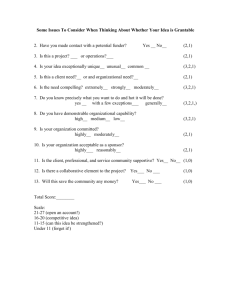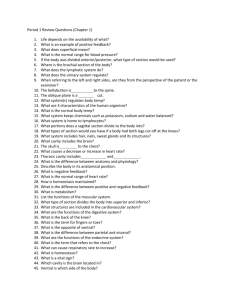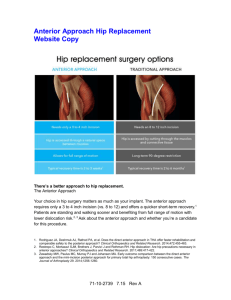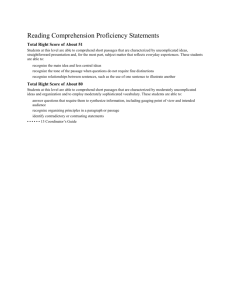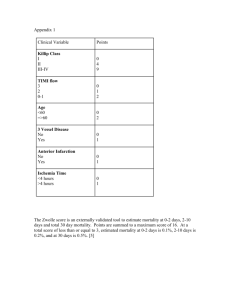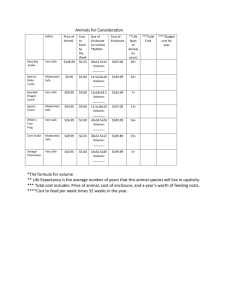with descriptions of three new taxa
advertisement
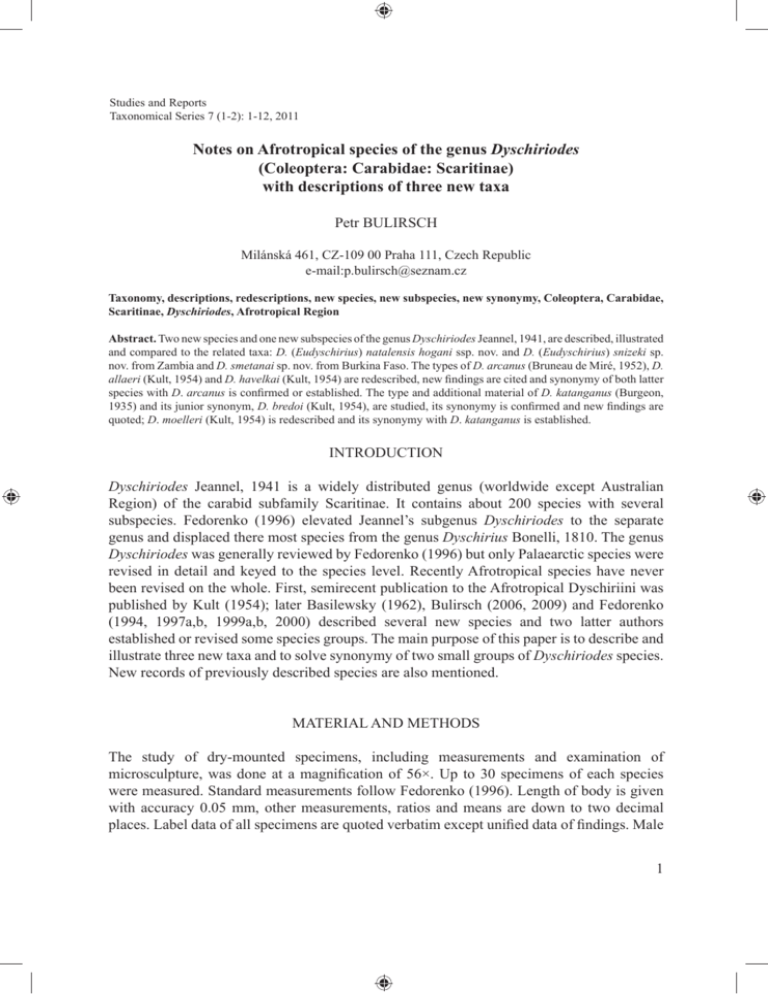
Studies and Reports Taxonomical Series 7 (1-2): 1-12, 2011 Notes on Afrotropical species of the genus Dyschiriodes (Coleoptera: Carabidae: Scaritinae) with descriptions of three new taxa Petr BULIRSCH Milánská 461, CZ-109 00 Praha 111, Czech Republic e-mail:p.bulirsch@seznam.cz Taxonomy, descriptions, redescriptions, new species, new subspecies, new synonymy, Coleoptera, Carabidae, Scaritinae, Dyschiriodes, Afrotropical Region Abstract. Two new species and one new subspecies of the genus Dyschiriodes Jeannel, 1941, are described, illustrated and compared to the related taxa: D. (Eudyschirius) natalensis hogani ssp. nov. and D. (Eudyschirius) snizeki sp. nov. from Zambia and D. smetanai sp. nov. from Burkina Faso. The types of D. arcanus (Bruneau de Miré, 1952), D. allaeri (Kult, 1954) and D. havelkai (Kult, 1954) are redescribed, new findings are cited and synonymy of both latter species with D. arcanus is confirmed or established. The type and additional material of D. katanganus (Burgeon, 1935) and its junior synonym, D. bredoi (Kult, 1954), are studied, its synonymy is confirmed and new findings are quoted; D. moelleri (Kult, 1954) is redescribed and its synonymy with D. katanganus is established. INTRODUCTION Dyschiriodes Jeannel, 1941 is a widely distributed genus (worldwide except Australian Region) of the carabid subfamily Scaritinae. It contains about 200 species with several subspecies. Fedorenko (1996) elevated Jeannel’s subgenus Dyschiriodes to the separate genus and displaced there most species from the genus Dyschirius Bonelli, 1810. The genus Dyschiriodes was generally reviewed by Fedorenko (1996) but only Palaearctic species were revised in detail and keyed to the species level. Recently Afrotropical species have never been revised on the whole. First, semirecent publication to the Afrotropical Dyschiriini was published by Kult (1954); later Basilewsky (1962), Bulirsch (2006, 2009) and Fedorenko (1994, 1997a,b, 1999a,b, 2000) described several new species and two latter authors established or revised some species groups. The main purpose of this paper is to describe and illustrate three new taxa and to solve synonymy of two small groups of Dyschiriodes species. New records of previously described species are also mentioned. MATERIAL AND METHODS The study of dry-mounted specimens, including measurements and examination of microsculpture, was done at a magnification of 56×. Up to 30 specimens of each species were measured. Standard measurements follow Fedorenko (1996). Length of body is given with accuracy 0.05 mm, other measurements, ratios and means are down to two decimal places. Label data of all specimens are quoted verbatim except unified data of findings. Male 1 genitalia (aedeagi) were embedded in Canada Balsam (male holotypes) or fixed with watersoluble glue. The following abbreviations are used to indicate the depository of specimens: ADWA Alexander Dostal private collection (including Karel Kult’s collection), Wien, Austria; FGGC François Génier private collection, Gatineau, Canada; HNHM Hungarian National History Museum, Budapest, Hungary; MNHN Muséum national d´histoire naturelle, Paris, France; OUMN Hope Entomological Collections, Oxford University of Natural History, Oxford, UK; PBPC Petr Bulirsch private collection, Praha, Czech Republic; PSHG Peter Schüle private collection, Herrenberg, Germany; SFPI Sergio Facchini private collection, Piacenza, Italy; ZMBG Museum fur Naturkunde der Humboldt-Universitat zu Berlin, Germany. Other abbreviations: ASP: apical setiferous puncture(s); BSP: basal (prescutellar) setiferous puncture(s); DSP: dorsal setiferous puncture(s); PASP: preapical setiferous puncture(s); PHSP: posthumeral setiferous puncture(s); HT: holotype(s); PT: paratype(s); [pr]: printed; [hw]: handwritten RESULTS Dyschiriodes (Eudyschirius) natalensis hogani ssp. nov. (Fig. 1) Type material. Holotype (♂): ‘Zambia: Central Province./ Lusaka nr Chisamba village./ Mubanga Farm. Alt. 1152m/ S 14´59.085; E 028´13.670/ 8.xii.2005, Coll. S. Beynon// Rough grassland, scrub/ bordering grazed field./ Cattle-dung baited/ pitfall trap./ OUMNH-2007-071’, (OUMN). Paratypes: (5 specimens): with the same data as HT, (OUMN, PBPC); (1 ♂): ‘Zambia: Lusaka/Huntley Farm, Chisamba/ S 15°01.641´ E 028°08.931´/ 1111 m alt. 25.xi.-2.xii.2005/ coll. S. Beynon & M. Jubb// Pitfall trap./ OUMNH-2007-071/ Oxford’, (OUMN); (1 ♂): ‘Zambia: Chisamba./ Kallindu Farm./ Alt. 1173m/ S 14°59.353´´ E 28°12.981´´/ 28.i.2010 coll. S. Beynon// Dung baited pitfall./ OUMN-2010-010/ S. Beynon Colln./ Ox.Uni.Mus.Nat.Hist./(OUMN) Hope Ent. Coll.’, (OUMN). Description. Habitus as in Fig.1; length 2.20-2.40 mm (HT 2.30 mm, mean 2.29 mm; n = 8). Colour of head and pronotum from rusty red to dark brown (incl. HT); distinctly to slightly lighter than elytra; latter from rusty brown to dark brown; elytral base and latero-apical part lighter; surface without bronze metallic lustre; legs rusty red, antennae and mouth-parts lighter. Head. Anterior margin of clypeus with moderately protruded lateral lobes, between them straight; clypeofrontal area with broad, deeply impressed, transverse furrow; facial furrows deep and narrow, parallel in anterior third, then strongly, diverged posteriorly; distance between them distinctly larger than eye length. Surface even, smooth, with very fine and sparse micropunctures. Eyes rather small, moderately convex. Antennae submoniliform. Pronotum. Strongly convex, outline distinctly rounded before anterior and below posterior setiferous punctures, slightly to moderately rounded between punctures; slightly to very 2 slightly attenuated anteriorly; 1.08-1.15 (HT 1.13, mean 1.12) times as wide as long, 1.441.52 (HT 1.45, mean 1.48) times as wide as head, widest in second third. Anterior angles very blunt, narrowly rounded, posterior ones moderately rounded. Fontal transverse impression distinct, deep, sparsely and irregularly punctate; median line fine, especially in middle; lateral channel moderately broad, reflexed lateral margin extended slightly beyond posterior setiferous puncture. Surface mirror-like shiny, with very fine micropunctures. Elytra. Short-ovate 1.47-1.53 (HT 1.51, mean 1.50) times as long as wide, 1.17-1.26 (HT 1.22, mean 1.22) times as wide as pronotum; humeri rather slightly to moderately protruded, each elytron with distinct, sharp tooth; elytral base moderately sloping; outline strongly broadened on sides, broadest at about anterior third, more strongly attenuated towards apex than towards humeri; suture not depressed at base. Base with vestigial rest of basal border, without tubercles; BSP missing. Striae 1-4(5) deep in basal two third; roughly punctate, striae punctation disappearing apically; striae 5(6)-8 consisting of rows of punctures gradually finer laterally, especially stria 8 fine; stria 1 almost complete, slightly finer on apical inclination, striae 2-4 disappearing in apical fourth, lateral ones gradually more shortened, disappearing in apical third to half; intervals moderately vaulted in basal part, flattened latero-apically. Three PHSP, three DSP (in middle of interval 3), two ASP (in deep apical stria). Protibia. Apical spine moderately curved backwards, not inwards, just longer than almost direct apical spur; distal marginal tooth moderately large, sharp, proximal one very small, blunt. Aedeagus. Length 0.45 mm in HT; as in nominotypical subspecies; shape is in Figs 2.1, 2.10-12 in Fedorenko (1997b). Differential diagnosis. D. natalensis hogani ssp. nov. can be distinguished from D. natalensis natalensis Fedorenko, 1997 by head with eyes on average smaller (distance between facial furrows distinctly larger than eyes length in D. n. hogani ssp. nov. and slightly larger in D. n. natalensis); pronotum narrower, on average more attenuated anteriorly (ratio width/length 1.08-1.15 in D. n. hogani ssp. nov., 1.02-1.07 in D. n. natalensis, 5 non-type specimens and 1.04-1.10 in its original description); elytra shorter (ratio length/width 1.45-1.52 in D. n. hogani sp. nov., 1.56-1.61 in D. n. natalensis, 5 non type species, 1.54-1.59 in its original description), distinctly ovate (slightly ovate in D. n. natalensis), outline more broadened in anterior third; each elytron with sharp humeral tooth (indistinct in D. n. natalensis). The shape of the median lobe of the aedeagus is as in nominotypical subspecies (as in Figs 2.1 and 2.10-12 in Fedorenko, 1997b). Name derivation. Patronymic, in honour of James Hogan, OUMN, Oxford, GB. Dyschiriodes snizeki sp. nov. (Figs 2, 2a,b) Type material. Holotype (♂): ‘Kenya Eastern/ E 729, Sosoma/ 202 km E of Thika/ 20.xi.2007, Snížek’, (ADWA). Paratype: (1 ♀): with the same data as HT, (PBPC). Description. Habitus as in Fig. 2; length 2.90 mm in HT and 2.95 mm in PT. Dark brown, surface with bronze lustre; head and elytral base slightly; apex very distinctly lighter, yellowish; legs, antennomeres and mouth-parts rusty yellowish. 3 Head. Anterior margin of clypeus with distinctly protruded, rather sharp lateral lobes, between them slightly convex; clypeofrontal area with very deep and broad transverse furrow; facial furrows deep, long, strongly diverged in posterior half; distance between them narrower than eyes length. Surface vaulted, even, smooth, with very fine and sparse micropunctures. Eyes relatively large, convex. Antennae submoniliform. Pronotum. Strongly convex, outline regularly rounded; indistinctly attenuated anteriorly; in HT 1.12 times and in PT 1.13 times as wide as long, in HT 1.47 times and in PT 1.40 times as wide as head; widest in/before posterior third. Anterior angles rounded, posterior ones broadly rounded. Anterior transverse impression deep, without punctures and cross striae; median line superficial; lateral channel moderately broad, reflexed lateral margin not extended below posterior setiferous puncture. Surface mirror-like shiny, with very fine punctures along anterior part of median line. Elytra. Very strongly convex, short ovate, laterally not concave in anterior fourth; in HT 1.51 times and in PT 1.49 times as long as wide, in HT 1.29 times and in PT 1.32 times as wide as pronotum; humeri distinctly protruded, elytra without humeral teeth; base in HT rather slightly, in PT very slightly sloping; outline strongly broadened on sides, broadest at about anterior third; suture not depressed at base. Base without basal border and tubercles; BSP large, connected with stria 1. Striae 1-7 moderately deep, densely punctate in anterior two thirds; stria 8 consisting of rows of minute punctures in anterior second fourth; striae and its punctation weakened in apical fourth (first striae) to third (lateral ones); latero-apical area with sparse and minute punctures; intervals moderately vaulted in anterior two thirds, slightly flattened latero-apically. Three PHSP, three DSP (in middle of interval 3) and two ASP (in deep apical stria). Protibia. Apical spine moderately curved downwards, slightly inwards, slightly longer than apical spur; latter slightly curved apically; distal marginal tooth moderately large, sharp, proximal one small, blunt. Aedeagus. Length 0.50 mm in HT; shape is in Figs 2a,b; apical lamella ventrally short, broadly rounded. Differential diagnosis. Dyschiriodes snizeki sp. nov. belongs to the D. (Eudyschirius) orientalis group (s. Fedorenko 1999a). D. snizeki sp. nov. is habitually most similar to two sibling species D. (E.) schaumii schaumii (Putzeys, 1866), D. (E.) flavicornis (Péringuey, 1896) (s. Fedorenko 1999a) and to D. gerardi (Burgeon, 1935). D. snizeki sp. nov. can be distinguished from all these species by elytra more broadly ovate, distinctly shorter (index length/width 1.49-1.51 in D. snizeki sp. nov. and 1.54-1.67, mean about 1.60, in all others species), with striae 1-7 punctation weakened but not disappeared latero-apically, moreover from D. gerardi by much deeper elytral striae punctuation. It differs from all these species by short and broad apical lamella of the aedeagus in ventral view; in D. schaumii schaumii is lamella moderately long and narrow, in D. gerardi and D. flavicornis is very long and narrow as in Figs 3 and 2, 6 in Fedorenko (1999a). Name derivation. Patronymic, in honour of Miroslav Snížek (České Budějovice, Czech Republic), collector of both type specimens. 4 Dyschiriodes (Dyschiriodes) smetanai sp. nov. (Fig. 3) Type material: Holotype (♀): ‘Burkina Faso/ Kompienga, 160 m/ 21.viii.2005// 11°05´05´´N,/ 00°42´42´´E/ Leg. P. Moretto’ (PBPC). Paratype (1 ♀): ‘Burkina Faso: Kompienga/ 15 km E Nadiagou, 155 m/ 11°04´31´´N, 000°56´08´´E/ 22.viii.2005, F. Génier/ zone soudanienne sud/ piège lumineux, 2005-40’, (FGGC). Description. Habitus as in Fig. 3; length 3.40 mm in HT and 3.50 mm in PT. Dark rustybrown, surface without metallic lustre; head in its anterior part, elytral base slightly, apex distinctly lighter; legs rusty red, antennomeres and mouth-parts lighter. Head. Anterior margin of clypeus with distinctly protruded, narrowly rounded lateral lobes, between them moderately convex; clypeofrontal area with deep transverse furrow on level of anterior margin of eyes; second much finer and irregular transverse furrow on/before level of midlength of eyes; facial furrows deep, long, strongly diverged in posterior half; distance between them slightly narrower than eyes length. Surface vaulted, even, smooth, with very fine and sparse micropunctures. Eyes relatively large, convex. Antennae submoniliform. Pronotum. Convex, outline regularly rounded; attenuated anteriorly; in HT 1.08 times and in PT 1.04 times as wide as long, in HT 1.41 times and in PT 1.38 times as wide as head; widest in posterior third. Anterior angles blunt, posterior ones broadly rounded. Anterior transverse impression distinct, with sparse punctures and cross striae; median line moderately deep, deepened posteriorly; lateral channel moderately broad, reflexed lateral margin extended markedly below posterior setiferous puncture. Surface mirror-like shiny, with very fine micropunctures. Elytra. Convex, ovate, laterally very slightly, broadly concave in anterior fourth; in HT 1 2 3 Figs 1-3. Habitus of holotypes (actual length in parentheses behind). 1- Dyschiriodes natalensis hogani ssp. nov. (2.30 mm); 2- D. snizeki sp. nov. (2.90 mm); 3- D. smetanai sp. nov. (3.40 mm). 5 2a Figs 2a,b. Dyschiriodes snizeki sp. nov. (actual lenght in parentheses behind); 2a- Aedeagus of holotype from right lateral view (0.50 mm); 2b- Apex of aedeagus of holotype from ventral view. 2b 1.59 times and in PT 1.62 times as long as wide, in HT 1.18 times and in PT 1.23 times as wide as pronotum; humeri distinctly protruded, each elytron with sharp humeral tooth; base slightly sloping; outline regularly broadened on sides, broadest slightly below anterior third; suture indistinctly depressed at base. Base with indistinct, vestigial basal border and without tubercles; BSP moderately large, rather slightly connected with stria 1. Striae 1-5 moderately deep, densely punctate in anterior two thirds, striae 6 slightly and stria 7 distinctly finer; stria 8 consisting of rows of 5-7 minute punctures in second third of length; striae and its punctation weakened in apical third (first striae) to half (lateral ones); latero-apical area with rests of minute punctures; intervals moderately vaulted in anterior two thirds, flattened latero-apically. Three PHSP, three DSP (in middle of interval 3) and two ASP (in rather fine apical stria). Protibia. Apical spine moderately curved downwards not inwards, as long as apical spur; latter slightly curved apically; distal marginal tooth large, sharp, proximal one small, blunt. Differential diagnosis. Dyschiriodes smetanai sp. nov. has not any closely related species. It is known in two females and its final assignment to species group will be possible after finding of male. D. smetanai sp. nov. is habitually most similar to species of the D. chalybeus group (s. Fedorenko 2000), especially to D. genieri Bulirsch, 2009, D. mortchaensis (Bruneau de Miré, 1952) and D. arcanus (Bruneau de Miré, 1952). D. smetanai sp. nov. can be distinguished from these three species by elytra with striae disappearing latero-apically, moreover from sympatric D. genieri by body larger (3.40-3.50 mm in D. smetanai sp. nov. and 3.00-3.30 mm in D. genieri) and elytra shorter (elytral ratio 1.59-1.62 in D. smetanai sp. nov. and 1.63-1.71 in D. genieri) and more ovate; from D. mortchaensis by body smaller (3.40-3.50 mm in D. smetanai sp. nov. and 3.60-4.00 mm in D. mortchaensis), head with different clypeofrontal structure and by elytra ovate, much shorter (elytral ratio 1.59-1.62 in D. smetanai sp. nov. and 1.73-1.82 in D. mortchaensis) and finally, from D. arcanus mainly 6 by body much darker and much stouter (elytral ratio 1.59-1.62 in D. smetanai sp. nov. and 1.80-1.91 in D. arcanus). D. smetanai sp. nov. can be distinguished from habitually a bit similar Afrotropical species of the D. orientalis group (D. flavicornis (Péringuey, 1896), D. gerardi (Burgeon, 1935), D. schaumii schaumii (Putzeys, 1866), D. fulvus Fedorenko, 1999 and D. snizeki sp. nov.) by different colour, head with two transverse furrows (only single transverse or broadly v-shaped furrow in all species of D. orientalis group) and by pronotum distinctly less vaulted laterally, with deep median line (superficial in Afrotropical species of D. orientalis group). Name derivation. Dedicated to Aleš Smetana (Ottawa, Canada), famous specialist in Staphylinidae, on the occasion of his 80th birthday. Dyschiriodes (Dyschiriodes) arcanus (Bruneau de Miré, 1952) Dyschirius arcanus Bruneau de Miré, 1952: 55. Dyschiriodes arcanus: Fedorenko (1996): revised generic placement. Dyschirius allaeri Kult, 1954: 328. Dyschirius arcanus (= allaeri): Basilewsky (1961): synonymy established. Dyschiriodes arcanus (= allaeri): Fedorenko (1996): revised generic placement, synonymy confirmed. Dyschirius havelkai Kult, 1954: 331 Dyschiriodes havelkai: Fedorenko (1996): revised generic placement. Dyschiriodes arcanus (= havelkai) syn. nov. D. arcanus (Bruneau de Miré, 1952), D. havelkai (Kult, 1954) and D. allaeri (Kult,1954) are three closely allied taxa of the nominotypical subgenus, allied to the D. chalybeus group (s. Fedorenko, 2000). I have studied HT of first two species, PT of the latter one and several non-type specimens from diverse regions. These species are redescribed/reviewed below, new findings are quoted and synonymy of both latter species to D. arcanus is confirmed or established. Dyschiriodes (Dyschiriodes) arcanus (Bruneau de Miré, 1952) Type material examined. Holotype (unsexed spec.): ‘[hw] Sénégal/ Saint Louis/ 6.x.1947// [printed on red label] TYPE// [hw] Dyschirius/ arcanus, Miré// Muséum/ Paris’, (MNHN). Additional material examined. SUDAN: ‘Sudan, Prov./ North Darfur, El/ Geneina, 9.viii.1977/ lux, leg. H. J. Bremer// Zool. Mus./ Berlin// Dyschirius arcanus/ B. de Miré.Fedorenko det 1991’, 1 spec., (ZMBG); GAMBIA: ‘Gambia: Upper River Div./ Jimara Dist., Mansajang Kundu/ Basse Government Rest House/ 13°17´N 14°13´W/ 25.viii.1997, MV light/ OUMN-1998-006’, 1 spec., (OUMN); BURKINA FASO: ‘Burkina Faso/ Nadiaou/ 11°04´31N 0°56´05W/ 22.viii.2005/ leg, P. Moretto’, 1 spec., (PBPC);,Burkina Faso, Sanguie/ Boromo, Sorobouli Forest/ 270 m, 11°47’44 N, 2°53’25 W, 10-15.viii.2005/ Philippe Moretto lgt.’, 8 spec., (PBPC, PSHG, SFPI); ‘Burkina Faso: Balé/ Boromo, 250 m/ 11°45´06´´N, 002°51´58´´O [ouest=west]/ 10.viii.2005, F. Génier/ zone soudanienne sud, piège lumineaux, 2005-10’, 4 spec., (FGGC, PBPC); ‘Burkina Faso: Passoré/ 8 km S.O. Yako, 320 m/ 12°51´44´´N, 002°18´35´´O[=west]/ 7.viii.2005, F. Génier/ zone soudanienne nord/ piège lumineaux, 2005-02’, 6 spec., (FGGC, PBPC); SENEGAL: ‘Sénégal: Saint-Luis/ Richard-Toll/ 16°26´25´´N 15°39´29´´ O, 9m/ 1.ix.2009, zone soudanienne, piege lumineux/ F. Genier’, 1 spec., (PBPC); ‘Sénégal: Kolda/ Forêt de Bakor, Mahon/ 12°51´30´´N 14°49´40´´ O, 35m/ 5.ix.2009, zone soudanienne piege lumineux/ F. Genier’, 3 spec., (PBPC, FGGC); ‘Senegal/ Nianing/ lumiere 21.viii.2008/ A. Coache leg.’, 1 spec., (PBPC);Senegal, Diouroup, 4-8. viii.2007, P. Moretto leg.’, 4 spec., (PSHG, PBPC); ‘Senegal/ Fatick/ 14-19.viii.2007/ leg P. Moretto’, 20 spec., 7 (PBPC); CONGO: ‘Soil-Zoological Exp./ Congo Brazzaville/ Kindamba, Méya, settlement// 12.xi.1963, No 185, by lamplight, leg. Endrödy-Younga’, 1 spec., (PBPC); BENIN: ‘Africa Benin c. or./ 55 km N of/ Save, 21.vi.2001/ F+L Kantner’, 1 spec., (PBPC); GHANA: ‘Ghana: Northern region/ Banda Nkwanta/ 150m, N 8 22- W 2 08/ Dr. S. Endrödy-Younga/ Nr.57/ light trap/ 14-18.viii.1965’, 1 spec., (HNHM); ‘NIGERIA, 5.VI.2010/ 0°5´33´´N, 7°45´15´´E/ 25km E of Abuja, 400m/ V. Kremitovský leg.´, 1 spec., (PBPC). Redescription (based on HT). Length 3.60 mm. Colour rusty yellow-brown, apical part of elytra, mouth-parts and antennomeres (in both antennae antennomeres 3-11 missing) yellowish, without metallic lustre. Head. Anterior margin of clypeus with moderately sharp, distinctly protruded lateral lobes, between them straight, clypeofrontal area with deep transverse furrow on level of anterior margin of eyes; second much finer and irregular transverse furrow on level of midlength of eyes; before anterior and between both furrows very blunt transverse ridge; facial furrows very deep and broad, parallel in anterior half, strongly divergent posteriorly; distance between them slightly narrower than eye length. Surface vaulted and smooth, with fine and sparse micropunctures. Eyes large and strongly convex. Pronotum. Strongly convex, outline moderately rounded, rather slightly attenuated anteriorly; 1.02 times as wide as long, 1.35 times as wide as head; widest below anterior two thirds of length. Anterior angles narrowly, posterior ones moderately broadly rounded. Anterior transverse impression very deep, impunctate, with fine and sparse cross striae; median line deep on disc, deepened and broader before base; lateral channel moderately broad, reflexed lateral margin extended markedly beyond posterior setiferous puncture. Surface mirror-like, shiny, with fine micropunctures. Elytra. Convex, long ovate, 1.80 times as long as wide, 1.16 times as wide as pronotum; humeri protruded, each elytron with obtuse humeral tooth; base rather slightly sloping; outline broadened below humeri, broadest above anterior third; suture not depressed at base. Base with distinct basal border and without tubercles; BSP small, moderately deeply connected with stria 1. Striae 1–7 deep along entire length, striae (2-)3 slightly weakened and 4-5 distinctly deepened at base; all striae densely and moderately deeply punctate in anterior part; punctation gradually disappearing latero-apically, stria 8 much finer, shortened anteriorly, very superficial and interrupted in middle third and fine in posterior third. Intervals distinctly vaulted. Three PHSP, three DSP (anterior in interval 3, middle and posterior in/near stria 3) and two ASP (in deep apical stria). Protibia. Apical spine slightly curved downwards but not inwards, as long as apical spur; the latter thinner, slightly curved; distal marginal tooth large, sharp, proximal one small, blunt. Aedeagus. Shape as in Fig. 5 in Bruneau de Miré (1952). Apical lamella of median lobe long and narrow, paramere without seta. Dyschiriodes havelkai (Kult, 1954) Type material. Holotype (♀): ‘[hw] Nigeria/ Kano// [printed on red label] TYPE// [hw] D. Havelkai Kt./51 [pr] det. K. Kult// [hw] Havelkai Kt./ [pr] det K. Kult’, (ADWA). 8 Redescription (based on HT) Length 3.50 mm. Colour as in preceding species. Head. As in preceding species except sharper transverse ridge before anterior and especially between both transverse furrows. Pronotum. As in preceding species; 0.98 times as wide as long, 1.31 times as wide as head. Elytra. As in preceding species except: slightly longer, 1.89 times as long as wide, 1.17 times as wide as pronotum, base slightly slopping to humeri, with finer basal border. Dyschiriodes allaeri (Kult, 1954) Type material. Paratype (♂): ‘[pr] Coll. Mus. Congo/ Elisabethville/ ii.1940/ H. J. Brédo// R. det./ X/ 5100// [printed on red label] TYPE// [hw] D. Allaeri// [hw] Allaeri/ [pr] det K. Kult’, (ADWA). Additional material examined. ‘Kinchassa/ Waelbroeck/ 10.ii.1896// Compared with / TYPE/ K. Kult 1947// D. allaeri Kt/ det K. Kult.’, 1 spec., (ADWA). Redescription (based on PT). Length 3.45 mm. Colour as in preceding species. Head. As in preceding species except: clypeofrontal structure, composed from few irregular, more or less transverse furrows and ridges (by non type specimen irregularly rugose). Pronotum. As in preceding species except: 1.02 times as wide as long, 1.24 times as wide as head. Anterior transverse impression deep, with rough cross striae; median line deep on disk and very deep at extremities. Elytra. As in preceding species except:1.89 times as long as wide, 1.19 times as wide as pronotum; humeri protruded, each elytron with indistinct humeral tooth; base slightly sloping; outline very slightly broadened below humeri, broadest before midlength. Base with vestigial, in middle interrupted basal border. Striae 1–7 deep along entire length, striae 4-5 deepened at base; all striae densely and moderately deeply punctate in anterior part; punctation gradually disappearing apically, stria 8 slightly finer, shortened anteriorly, moderately deep in posterior two thirds. Intervals distinctly vaulted. Discussion. D. arcanus was described by Bruneau de Miré in 1952 and remaining two species by Kult two years later. Kult very probably did not known the description of D. arcanus and he did not compare both his species with D. arcanus. Basilewsky (1961) synonymised D. allaeri to D. arcanus based on study of both types. D. havelkai differs from D. arcanus only by slightly different structure of head, elytral base with finer basal border, not distinctly sloping to humeri and by measurement (especially by longer elytra). All these characters are within species variability and D. havelkai is a junior synonym to D. arcanus. D. allaeri differs from D. arcanus only by the structure of head and by elytra with base slightly sloping to humeri, with finer basal border; with slightly deeper elytral striae 1-7 and distinctly deeper stria 8. Among about 50 studied type and non-type specimens of D. arcanus s. l., the structure of the clypeofrontal area is not constant: whereas by specimens from Senegal, Benin, Nigeria and DR Congo is relatively stable, typical to D. arcanus or D. havelkai; by specimens from Burkina Faso it varies among structures of all above redescribed species (it is mostly similar to D. allaeri). Both specimens from DR Congo have deeper striae, especially stria 8, and 9 all the remaining specimens have stria 8 as in HT of D. arcanus. As mentioned above, the structure of the head varies even within population from the same locality and/or among specimens from different countries and more or less deepened elytral striae (especially stria 8) is not a sufficient character to keep a separate species status of both taxa and the synonymy proposed by Basilewsky (1961) and confirmed by Fedorenko (1996) is correct. Distribution. D. arcanus (= allaeri, havelkai): Senegal, PD Congo, Nigeria, Burkina Faso, Sudan, Gambia, Congo, Ghana. Dyschiriodes katanganus (Burgeon, 1935) Dyschirius katanganus Burgeon, 1935: 156. Dyschirius bredoi Kult, 1954: 329. Dyschiriodes katanganus (= bredoi): Fedorenko (1996): revised generic placement, synonymy established. Dyschirius moelleri Kult, 1954: 332 Dyschiriodes moelleri: Fedorenko (1996): revised generic placement. Dyschirius katanganus (= moelleri) syn. nov. D. katanganus (Burgeon, 1935), D. bredoi Kult (1954) and D. moelleri Kult (1954) are three closely allied taxa. Fedorenko (1996, 1999) redescribed D. katanganus and correctly signed D. bredoi as a junior synonym of this species. D. bredoi differs only by the presence of BSP. I have studied 7 specimens (including one PT) of D. katanganus and HT of D. moelleri (Kult, 1954). The latter species is redescribed below and its synonymy with D. katanganus is established. Dyschiriodes katanganus (Burgeon, 1935) Type material. Paratype (♀) ‘Coll. Mus. Congo/ Elisabethville [= Lubumbashi]/ ii.1940/ H. J. Bredo// katanganus Kult/ det. K. Kult [19]46// PARATYPE/ [hw] D. Bredoi Kt./ [pr.] det. K. Kult, 1947 [m. bredoi]’ (ADWA). Additional material examined. PD CONGO: ‘Coll. Mus. Congo/ Elisabethville/ ii.1940/ H. J. Bredo// Compared with/ TYPE/ det. K. Kult 1946// katanganus Burg. det. K. Kult, 1947’, 1 spec., (ADWA); ‘Coll. Mus. Congo/ Elisabethville (A la/ lumiere) xi.1950/ Ch. Seydel’, 1 spec., (PBPC); ZAMBIA: ‘Zambia NC/ 27 km E Solwezi/ Snizek lgt.’, 1 spec., (ADWA); ‘Zambia NW/ 130 km W Solwezi/ 7.i.2003/ J. Halada leg.’, 1 spec., (PBPC); ‘Zambia - Lusaka/ Kafue City - Kafue River/ m.1200, 22.xi-2.xii.1987/ R. Mourglia legit [m. bredoi]’, 1 spec., (PBPC); ‘N.W. Rhodesia:/ Lukanga./ iv.1915/ H. C. Dollman// Bredoi Kt/ det. K. Kult [m. bredoi]’, 1 spec., (ADWA). Measurements. Length of body 2.90-3.40 mm (mean 3.17 mm, n=7); pronotum 1.00-1.05 (mean 1.02) times as wide as long and 1.30-1.40 (mean 1.35) times as wide as head; elytra 1.71-1.79 (mean 1.76) times as long as wide and 1.17-1.21 (mean 1.18) times as wide as pronotum. Dyschiriodes moelleri (Kult, 1954) Type material. Holotype (♀): [hw] N. Rhodesia [= Zambia]/ L. Tanganyika/ Urungu: Kituta// [printed on red label] TYPE// [hw] D. Moelleri Kt./ 54 [pr.] det. K. Kult// [hw] Moelleri Kt./ [printed] det. K. Kult’, (ADWA). Redescription (based on HT). Length 3.15 mm. Colour fuliginous with slight bronze lustre, base and apical part of elytra slightly lighter, legs, mouth-parts and antennomeres rusty brown. 10 Head. Anterior margin of clypeus with moderately sharp, distinctly protruded lateral lobes, between them straight, clypeofrontal area with V-shaped furrow; facial furrows very deep and moderately broad, parallel in anterior half, strongly divergent posteriorly; distance between them as broad as eye length. Surface vaulted and smooth, with fine and sparse micropunctures. Eyes rather large and strongly convex. Pronotum. Strongly convex, outline rather slightly rounded, distinctly attenuated anteriorly; 1.05 times as wide as long, 1.34 times as wide as head; widest below anterior two thirds of length. Anterior angles narrowly, posterior ones moderately broadly rounded. Anterior transverse impression deep, punctate, without cross striae; median line fine on disc, slightly deepened and broader before base; lateral channel moderately broad, reflexed lateral margin extended slightly beyond posterior setiferous puncture. Surface mirror-like, shiny, with fine micropunctures. Elytra. Slightly ovate, dorsal surface slightly concave in anterior fourth in lateral view; 1.75 times as long as wide, 1.17 times as wide as pronotum; humeri protruded, without humeral teeth; base slightly sloping; outline slightly broadened below humeri, broadest below anterior third; suture slightly depressed at base. Base without basal border and without tubercles; BSP small, moderately deeply connected with stria 1. Striae 1–7 moderately deep, slightly weakened latero-apically; stria 8 very fine, consisting of a row of minute punctures in second third of length, just recognisable in posterior third before apical stria. Intervals moderately vaulted. Three PHSP, two DSP (anterior and posterior in interval 3, middle missing) and two ASP (in deep apical stria). Protibia. Apical spine slightly curved downwards but not inwards, as long as apical spur; the latter thinner, slightly curved; distal marginal tooth large, sharp, proximal one small, very blunt. Discussion. Kult (1954) distinguished D. moelleri from the closely allied species, D. katanganus (= D. bredoi), by missing middle DSP, more broadly V-shaped clypeofrontal furrow, deeper median line of pronotum and by shape and length of elytra. Based on Fedorenko´s redescription and study of 8 available specimens of both latter taxa, all these characters (except missing middle DSP) are within species variability and missing middle DSP is not sufficient to keep both taxa as separate species: D. moelleri is a junior synonym of D. katanganus. Distribution. D. katanganus (= bredoi, moelleri): DR Congo, Zambia, Botswana, RSA. ACKNOWLEDGEMENTS. My hearty thanks are due to Alexander Dostal (Wien, Austria); François Génier (Gatineau, Canada); Thierry Deuve and Azadeh Tagavian (both MNHN, Paris, France); Győző Szel (HNHM, Budapest, Hungary); Sergio Facchini (Piacenza, Italy); James Hogan (OUMH, Oxford, UK); Peter Schüle (Herrengen, Germany) and Bernd Jaeger (ZMBG, Berlin, Germany) for loans the type or unidentified specimens and/or for donating duplicate specimens. I am also thankful to Pavel Moravec (Litoměřice) and Martin Fikáček (Praha) for preparing of figures. REFERENCES BASILEWSKY P. 1961: Contribution a la connaissance des Coléoptères Carabidae de la région du Tchad. I. Carabides recueillis par le Dr. H. Franz. Revue Française d´Entomologie 28: 212-235. 11 BASILEWSKY P. 1962: Coléoptères Carabidae africains nouveaux XIII. Revue de Zoologie et Botanique Africains 65(1-2): 149-162. BRUNEAU DE MIRÉ Ph. 1952: Contribution a l’étude des Dyschiriinae (Col. Carabiques) du Sahara méridional et de ses confins Sahéliens. Annales de la Société Entomologique de France 121: 49-60. BULIRSCH P. 2006: Contribution to the knowledge of the tribe Dyschiriini from tropical Africa (Coleoptera: Carabidae: Scaritinae). Studies and Reports of District Museum Prague-East. Taxonomical series 2(1-2): 1529. BULIRSCH P. 2009: Contribution to the Asian and Afrotropical species of the genus Dyschiriodes (Coleoptera: Carabidae: Scaritinae). Acta Entomologica Musei Nationalis Pragae 49(2):559-576. BURGEON P. 1935: Catalogues Raisonnés de la Faune Entomologique du Congo Belge. Annales du Musée du Congo Belge 49(2):559-576. FEDORENKO D. N. 1994: Revision of a new species group, bengalensis, of the genus Dyschirius Bonelli, 1810, (Coleoptera, Carabidae), with description of one new species and one new subspecies. Russian Entomological Journal 3(1-2): 7-14. FEDORENKO D. N. 1996: Reclassification of world Dyschiriini, with a revision of the Palearctic fauna (Coleoptera, Carabidae). Pensoft Publishers, Sofia-Moscow-St. Petersburg, 224 pp. FEDORENKO D. N. 1997a: [Revision of Palearctic and Paleotropical species of the substriatus group, genus Dyschiodes, Jeannel, 1941 (Coleoptera, Carabidae)]. Entomologicheskoe Obozrenie 76: 135-152 (in Russian). FEDORENKO D. N. 1997b: [Review of the Dyschiriodes (Eudyschirius) of the species group orientalis (Coleoptera, Carabidae) with a revision of Indo-malayan species]. Zoologicheskiy Zhurnal 76: 667-675 (in Russian). FEDORENKO D. N. 1999a: New or little-known Dyschiriodes Jeannel, 1941, from Africa and SE-Asia (Coleoptera, Carabidae). Russian Entomological Journal 8(2): 115-121. FEDORENKO D. N. 1999b: On new or little-known Afrotropical Dyschiriodes Jeannel, 1941, from the minutus-group (Coleoptera,Carabidae). Russian Entomological Journal 8(3): 159-166. FEDORENKO D. N. 2000: On the Afrotropical representatives of the chalybeus-group of the genus Dyschiriodes Jeannel, 1941 (Coleoptera, Carabidae). Russian Entomological Journal 9(2): 113-122. KULT K. 1954: Revision of the African species of the genus Dyschirius Bonelli. Revue de Zoologie et Botanique Africaines 50: 315-341. Received: 22.2.2011 Accepted: 10.3.2011 12

